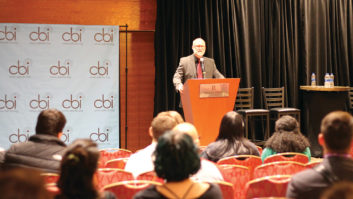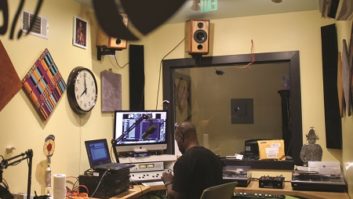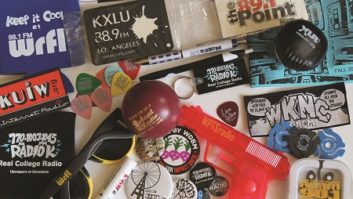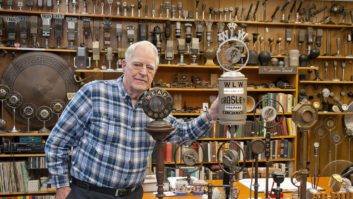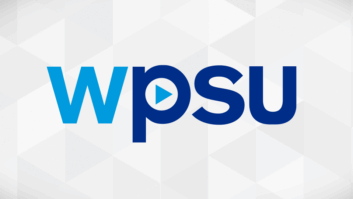
General Manager Jasmine Catchings outside the on-air studio of Howard University’s student-run radio station WHBC in 2015.

Sticker-covered filing cabinet full of CDs at KWVA(FM) at University of Oregon, 2015 In March 2008, I visited Emerson College’s tiny campus-only radio station WECB in Boston. Although I’d heard of its well-known sister WERS(FM), I was intrigued by the under-the-radar nature of WECB, the history of which dates to 1947.
Unlike its more competitive, tightly formatted sibling, WECB embraced a free-form ethos, and student DJs could play whatever they wanted from the station’s basement digs. Having gotten my start at a scrappy college radio station myself, at carrier-current WHRC(AM) at Haverford College, I was charmed.
That visit set in motion a long series of station tours. Although I’m still drawn to lesser-known, under-the-radar college stations like WECB, I’ve expanded my project to include all kinds of stations.
Eight years later, I’ve surpassed 100 station tour reports for the Spinning Indie and Radio Survivor blogs.
It’s been a fascinating journey (with no end in sight) and after reaching this milestone, it’s a good time to reflect on what I’ve learned from all of these visits.
I’ve been to 69 college radio stations, a half-dozen high school radio stations, three commercial radio stations not affiliated with colleges and 19 community/public radio stations, including some online-only outlets. I visited a religious station, NPR headquarters and a pop-up station put on by the Red Bull Music Academy.
My travels have taken me to 14 states, the District of Columbia and Ireland. Since I’m based in San Francisco, I’ve been to more radio stations in California (32) than any other state; but I’ve also managed to see stations in Illinois (10), Oregon (eight), Massachusetts (seven), Pennsylvania (six), New York (six), Washington (six), Georgia (four), Kentucky (four), D.C. (four), Minneapolis (three), New Jersey (two), Maryland (two), Indiana (two) and Virginia (one).
RADIO IS DIVERSE
The most obvious thing that I’ve learned along the way is that radio is diverse, particularly college radio. Even though I like to joke about some of the items that I regularly see at college radio stations — sticker-covered cabinets, stinky couches, graffiti, vintage equipment and hand-made call letter signs crafted by musician Leo Blais — no two stations are the same.

DJs in record library at WPRB in Princeton, N.J. Music Director Olivia Bradley-Skill in center (holding record), DJ Joshua Becker on the left and Educational Advisor Michael Lupica on the right. Physical locations vary tremendously, from the tiny storefront studio of East Village Radio in New York City, to the large complex at Radio K — KUOM(AM) — in Minneapolis, to SCAD Atlanta Radio’s dorm-based home in a converted mid-century motel.
Some stations are pristine and corporate-looking, whereas others scream creativity, with every inch covered with posters, band flyers, scrawled messages, music and pop culture artifacts. I’ve been to many stations with large physical music libraries, full of LPs, CDs, 7-inch records, cassettes and even reel-to-reels; I’ve also been to all-digital stations that may have a few CDs or records here and there, largely for decoration.
Station purposes and philosophies are all over the map. Some college and high school stations are deeply connected with curriculum and function much like a lab for a radio, communications or electronic media program. Others are campus clubs with little administrative oversight. At some stations, DJs are given the freedom to program their own shows, whereas others have prescribed playlists. Some are completely run by students, others may have professional leaders and DJs from the community.
Community radio stations also vary considerable. I’ve been to a number that are mostly music-oriented, including WFMU(FM) and BFF.fm in San Francisco, while others have a smorgasbord of music and public affairs shows. A few hybrid stations, like KZYX(FM) in Philo, Calif., air a mix of local music and talk shows as well as syndicated public radio programming.


BFF.fm founder Amanda Guest in San Francisco.KUOM (AM/FM) licensed to the University of Minnesota in St. Paul.HIDDEN HISTORY
I’ve always been interested in radio history, and one thing that I’ve learned is that often radio participants have a vague understanding of their station’s history.
There’s lore, of course, including tales of famous college radio alumni — from Howard Stern at Boston University���s WTBU to Dr. Demento at Reed College’s KRRC — as well as rumored visits by famous bands and celebrities.
Sometimes I’m able to do research in advance of my visits, and sometimes I reveal historical tidbits that were unknown to my tour guides.
I also like to see every nook and cranny of a station, and in the course of those explorations, gems are often uncovered in closets and file cabinets. Because I’ve asked questions like “What’s in that room?” staffers and volunteers have pulled out photo albums, old program guides and even 1940s transcription discs at high school radio station KBPS(AM) in Portland, Ore. I’ve seen so many fascinating historical objects, and in the past few years, I’ve started imploring stations to document their history, and in the case of college stations, to work with their campus archivists to preserve materials.

Station Manager Russell Tanzillo in front of wall of CDs at WONC, licensed to North Central College in Naperville, Ill.

University of Maryland’s WMUC Programming Director Sung-Min Kim stands in the Record Library.RADIO PASSION IS INFECTIOUS
As a long-time radio station volunteer, I’m comfortable in stations. When I plot out my travels, I get giddy with excitement thinking about all of the stations that I’d like to visit.
While the physical settings are intriguing to me, it’s the passion of radio participants that leaves a lasting impression. I usually meet with station managers who practically live at their stations. Their stories always inspire me.
Countless college radio station managers have recounted tales about bringing their stations back from the brink of death, and more recently, I’ve met with brand-new low-power FM operators who are part of an exciting radio renaissance thanks to the Local Community Radio Act.
I think of CHIRP Radio founder/General Manager Shawn Campbell. Since she was a little kid, she knew that she wanted to work in radio; after a series of jobs in commercial and non-commercial radio, she set out to create a new community station in Chicago. Work began in 2007, focused on advocating for the Local Community Radio Act so that more low-power FM licenses could be made available to community groups.
CHIRP launched its online stream in 2010 and was granted a LPFM construction permit in 2014 for its new station, WCXP(LP), which will hit the Chicago airwaves over 107.1 MHz soon.
It’s also incredible to meet young people who are at the beginning of their radio journeys and hearing their tales about being on the air for the first time. Just this summer a student mentioned to me her excitement and fear about going solo on the radio. Others have shared stories about great times at their college radio stations, from sleep-deprived 24 hour marathons to scoring an interview with a favorite band.
My heart is warmed when I show up to a station and historical artifacts are waiting for me. WHCS General Manager Sarah Settineri greeted me with a stack of vintage photos and an old station manual when I visited the Hunter College station in February of this year. Our conversation about the importance of radio history left such an impression on her that she accepted my invitation to come to the Radio Preservation Task Force conference in Washington the following weekend. I couldn’t have been happier.
Throughout my travels, I’ve been welcomed with open arms and my love for radio has been reinforced. It’s no surprise that I can’t wait to get back on the road.
The author is co-founder of Radio Survivor and co-chair of the College, Community and Educational Radio Caucus for the Library of Congress’ Radio Preservation Task Force.
Comment on this or any story. Email [email protected].
